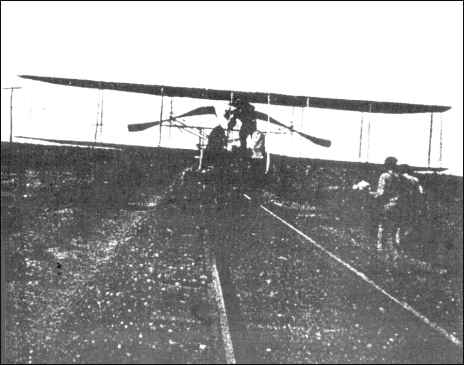
From the COLE BULLETIN, Vol 3, No. 2, FALL, 1997 Taken from Various Magazines Courtesy of Leroy D. Cole |
 |
|
Photo from the COLE BULLETIN, Vol 3, No. 2, FALL, 1997 Courtesy of Leroy D. Cole |
|
September 23, 1911. THE AUTOMOBILE JOURNAL; "With the Aviators" Considerable interest is being manifested in Fowler's machine, not alone because it is a Wright bi-plane, but on account of the fact that it is equipped with an automobile engine, one of the 30-40 horsepower motors utilized by the Cole Motor Car Company of Indianapolis, Ind., in Cole cars. It will be noted by the accompany table that its rating is much below that of the Wright motor with which these machines ordinarily are equipped. The performance of this engine will be watched with much anxiety throughout the contest, particularly by many Cole owners. |
|
September 30, 1911. AERO; "Slow Progress Made in Ocean-to-Ocean Race" Fowler will try the automobile motor because certain experiments made by him in California during the past year seemed to bear out his belief that the modern automobile engine would be more satisfactory in an aeroplane than the present type of aeronautic motor. This opinion was partly agreed to by the Wrights, it is said, after they had conferred with a group of automobile engineers upon the subject. The brothers were willing to admit that the automobile motor had certain arguments in its favor that would play important parts in future aviation. The Cole motor is 200 pounds heavier than the motor now used in the Wright machine, but it is claimed that it gives to the aviator more power and a better chance to handle his plane. Fowler is confident he will win the prize offered. "The question," he says, "is one that I have given thorough study. The flight is the greatest thing attempted in aviation circles. A man must use the greatest of judgment. He must be familiar with the difficultires he will encounter. I am sure my observations, for I have been studying the problem since last January, will carry me safely into New York. I have confidence in the motor." |
|
October 1, 1911. CYCLE AND AUTOMOBILE TRADE JOURNAL; "Aviators start on Coast-to-CoastRace" The first to start was Robert G. Fowler, who left San Francisco September 11th. He uses a Wright biplane, with a Cole motor as used in the automobile of that name. The attempt is being financed ty the Cole Motor Car Company, of Indianapolis, Inc. Fowler in his first day's flight covered 126 miles, alighting at Antrim, Cal. The second day he made several jumps, experiencing trouble with the steering gear. In alighting near Alta, Cal., he collided with some trees, and the machine was considerable smashed up. Repair parts were rushed from San Francisco, and on the 18th Fowler started again. |
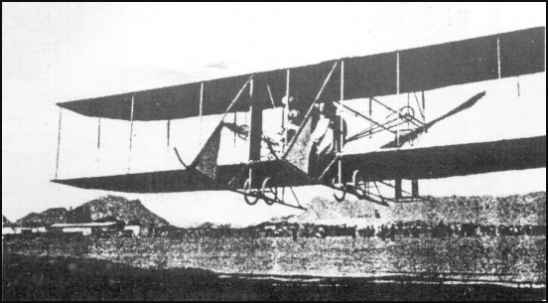 |
|
Photo from the COLE BULLETIN, Vol 3, No. 2, FALL, 1997 Courtesy of Leroy D. Cole |
|
October 14, 1911. THE AUTOMOBILE JOURNAL; "With the Aviators" While these two men had an opportunity to make excellent mileage, Robert G. Fowler was stalled at Colfax, Cal., which point he reached on the second day's flight from San Francisco. Fowler was entirely unknown as an aviator previous to his start on this race. He is flying a Wright biplane, equipped with a 30-40 horsepower Cole motor, the same engine that is utilized in the construction of Cole cars, made by the Cole Motor Car Company, Indianapolis, Ind. Because the physical characteristics of the United States are not as well known as those of Europe, for instance, it is generally supposed that the Alps offer the most unsurmountable barrier in the civilized world. As a result, the feat of Georges Chavez, the Peruvian aviator, who lost his life in a successful attempt to repeat the exploits of Napoleon and Hannibal with the most modern means of conveyance, is looked upon as the greatest achievement in the science of flying. Without detracting one whit from the memory of Chafez or of the most notable aviation demonstrations of 1910, it will be permissible to compare propositions. The Simplon pass, used by Chavez for his first flight, has an average altitude of about 4000 feet, and is 6592 feet at its highest point. The Sierras, over which Fowler elected to make his attempt, have an average of 6000 feet, and at Summit, the point where he was baffled, the altitude is 7071 feet. Chavez drove a Bleriot monoplane, fitted with 100 horsepower revolving Gnome engine. With this he was forced to fly 8000 feet above the sea in order to cross the Alps. Fowler reached Colfax Sept. 12, and in alighting damaged his machine badly. Ten days were occupied in making repairs and preparing for the most difficult task of the entire journey. Sept. 23, he left Colfax flying at an altitude of 5000 feet. This he increased to 6000 as he appeared over Blue Canyon. After trying for more than two hours, he was forced to return to Colfax. Although he made no landing at Blue Canyon, he is credited with reaching that point. Setp. 24 he made a second attempt, only to find the ari current even more treacherous than on the previous day. However, he reached an altitude of 7500 feet, according to his barograph, before he was force to land a Emigrant Gap. During this flight he came within a few miles of Summit, and would have been able to enter the pass, had it no been for the counter winds. Fowler made his third attempt Sept. 25, and this time he equaled Chavez's altitude, 8000 feet. Appearing at the mouth of the pass, between Cisco and Tamarack, he was confronted with an even worse maelstrom of air than previously. He spent one minute less than two hours in trying to avoid the mountain peaks before returning to Emigrant Gap, where he broke a skid in alighting. Whether or not Fowler eventually crosses the Sierras, his battle with the terrific air currents at the mouth of the pass on three successive days will go down in the history of aviation as a remarkable exhibition of skill. Too much credit cannot be accorded the little 30-40 horsepower automobile engine with which his machine was fitted. Compared with the work of the 100 horsepower Gnome equipped Bleriot, utilized by Chavez, the Cole Motor Car Company has every reason to be pleased with the performance of its product. |
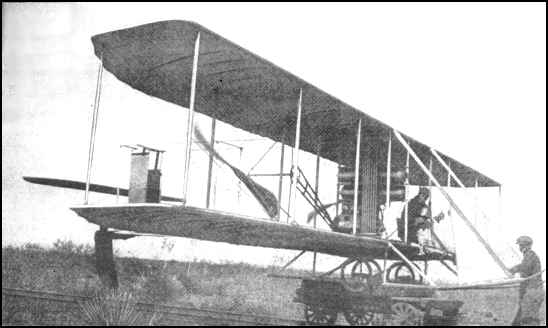 |
|
Pioneer airman Robert G. Fowler was forced down in the middle of sage and cactus in the New Mexico desert, during his famed west to east flight in 1911. He gained momentum for a take off by putting the plane on a push car on the railroad track nearby. The thrust of the propellers sent the whole outfit down the track with enough speed for the plane to take off. Photo from the COLE BULLETIN, Vol 3, No. 2, FALL, 1997 Courtesy of Leroy D. Cole |
|
January 13, 1912. AERO; NEW ORLEANS WAS INDIFFERENT TO FOWLER New Orleans, La., January 4 --Robert G. Fowler, the coast-to-coast aviator, drove his Wright Model B with Cole motor into New Orleans, Sunday, December 31, fron near Seixas, La., about 12 miles distant, wher he was compelled to alight Christmas eve, while flying from Morgan City, La., to New Orleans. He alighted in a rice field, his machine remaining there more than a week. Inclement weather has prevailed throughout this section for more than two weeks, which together with a broken spark plug, which developed on one start from a handcar, delayed his arrival until New Years eve, shortly after 3 p. m. Sunday was not an ideal day for flying, by any means. It was a damp, cloudy day and the wind was more than moderate, but Fowler was chafing under the enforced idleness, and when he left the city for Seixas that morning, he stated he was going to bring the "old kite in, weather or no weather," and he did. The machine was placed on a small, flat tool car, and a handcar behind furnished the motive power for a start. As the aeroplane left the car the north wind caught it, swinging the machine from above the rails and bringing the left wing directly into line with a cross-arm of a telegraph pole, but just as the watchers thought the jig was up, Fowler banked strenuously and brought the wing under the cross-arm by a narrow margin. Then he began his ascent. During the flight to the city Fowler continued to climb, and crossed the Mississippi river at a height of about 2,500 feet, and fought his way to City Park racetrack, though a north wind caught him at right angles all the way. A baker's dozen of watchers greeted his arrival in the metropolis of the south--after a trip of 2,100 miles. The air path the aviator followed brought him over Harakan, La., where John B. Moisant was killed just a year previous to the day, and later in his flight hovered over Metairie Cemetery, where Moisant was buried. From this point Fowler shut off his motor and glided gracefully to the wet racetrack. While Monday (New Year's day) was admittedly a bad day for outdoor attractions, considerably less than 300 people witnessed Fowler's two flights. If the ponies had been advertised, Jupiter Pluvius could not have kept thousands away. The aviator made one flight at about 500 feet, remaining up five minutes. His engine was not working smoothly, and he landed for inspection. The second time he mounted to about 900 feet, circling the park and over adjacent timber several times, remaining in the air seven minutes. Fowler's feat of crossing this section of the country should not be overlooked as one of the most daring ever undertaken anywhere, for the reason that for a distance of about 350 miles, from near west Lousiana to near Mobile, Ala., there is little choise between telegraph wires, dense timber, cane stubble, rice fields, lagoons, bayous, rivers, lakes, land and sea marsh and gulf waters to land in from New Orleans to Gulfport, Miss., on the next leg of th route, about 70 miles, it will be hard to find one good dry or safe landing place. Should he deviate from the L. & N. R. R., he would have to pass over almost inaccessible swamp. He flew 42 minutes in the rain in west Lousiana, and informed the writer that he is planning a rainshield, as it was hard to distinguish his way with wet goggles. He telegraphed to the Wrights for information as to a pontoon for a Model B, and was informed that none could be delivered inside of 10 days. As hs is determined to get away at the first favorable opportunity, he will not wait for it. J. R. Grundy has succeeded Sims in the financial end of the journey, the latter returning west. The staff has been reduced from eight to five. Leaving Quitman, Ga., at noon, he flew 28 miles to Greenville, Fla., and after circling that town three times he went on to Madison, Fla., which he treated in the same way and headed for Live Oak, Fla., where he landed at 1:10 p. m. Following an exhibition at Live Oak, Fowler flew to Montcrief Park, Jacksonville, a distance of 82 miles, in 90 minutes. Fowler was sighted about six miles west of Jacksonville at 4:27 p. m. by a wonderfully enthusiastic crowd. Even Max Lillie and Harold Kantner, who wre giving an exhibition, were so excited that they could not get into their machines quickly enough to fly out ot meet the trans-continentalist. Lillie was the first off the ground in his model B Wright, followed immediately by Kantner in his Moisant monoplane. They flew about four miles and after greeting Fowler by circling around him, they escorted him to the field. Lillie landed first to show Fowler the way. Then Fowler gave an exhibition, consisting of short circles, dips and rolls that made the big crowd gasp with wonder. He finally landed, followd by Kantner. When the yells of enthusiasm subsided Fowler's manager, Charles L. Young and Frank Gotch, champion wrestler of the world, and F. Albert, Lillie's managers, met the aviator and congratulated him. |
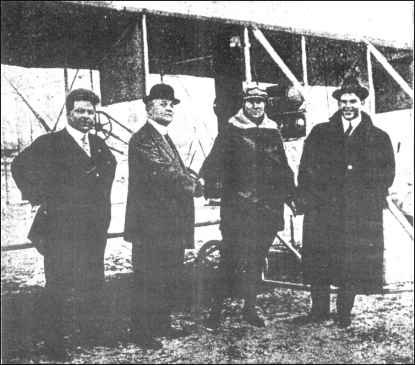 |
|
Photo from the COLE BULLETIN, Vol 3, No. 2, FALL, 1997 Courtesy of Leroy D. Cole |
|
Fowler was suffering with the cold from having been so long in the air, traveling at an altitude of
3,500 feet to be on the safe side in case of motor stoppage. He had to travel over territory that consisted of swamps and forests. The
landing was made at 4:47 p. m. The evening was spent at the Seminole cafe where Fowler was made the guest of honor of Champion Gotch and Young. |
|
January 20, 1912. AERO; "Fowler Reaches New Iberia, LA." New Iberia, La., December 21.--R. G. Fowler arrived here this afternoon at four o'clock from Jennings, La., He intends to stop here tomorrow in order to give an exhibition flight. Fowler entered Lousisiana on December 17, arriving at Lake Charles, La. On the day following he gave an exhibition in Lake Charles and on December 190 he was delayed by rain. On December 20 he flew to Jennings, carrying a photographer as passenger all of the way |
|
February 17, 1912. AERO; "Among the Aviators" Eugene Fowler, in his Wright, arrived at Thomasville, Ga., at 4 p.m., February 7. At 6 p.m. he left for Jacksonville, Fla., where he expects to end his ocean to ocean flight. He flew to Thomasville from Bainbridge, Ga. |
|
Febuary 25, 1912. THE AUTOMOBILE JOURNAL; "With the Aviators" For the second time the American Continent had been crossed by aeroplane, when Robert G. Fowler alighted at Moncrief Park, Jacksonville, Fla., Feb. 8. The first transcontinental flight was accomplished by Calbraith P. Rodgers in a Wright biplane. Fowler's machine was of the same make, althnhough it was fitted with a Cole automobile engine, made by the Cole Motor Car Company, Indianapolis, Ind. |
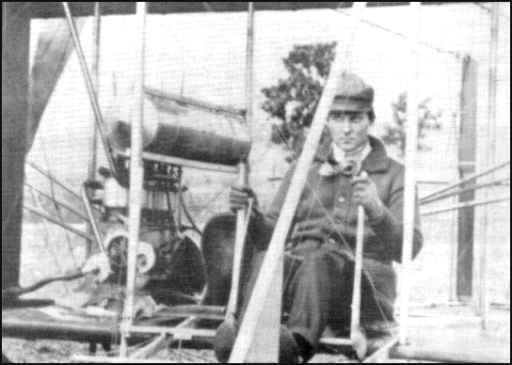 |
|
|
|
March 16, 1912. AERO; "Among the Aviators" Robert G. Fowler flew at Americas, Ga., March 6, for a purse of $500 offered by merchants there. He is said to be planning another trans-continental flight for this summer, starting from Pablo Beach, Fla., and finishing at San Francisco. W. F. Winchester, of Jacksonville, Fla., may accompany him in a second machine. |
|
March 23, 1912. AERO; "Among the Aviators" Robert G. Fowler, the transcontinentalist, expects to fly at Rome, Ga., on March 22. He has spent last week at Atlanta, Ga., |
|
March 30, 1912. AERO; "Among the Aviators" Robert G. Fowler, did not lose his enthusiasm for flying on his hard cross-country trip. "Flying is much safer than automobiling, and I would much rather risk it," he said in Atlanta, March 11. "Just as long as a man keeps a cool head, is sensible, and does not try to do something a bird cannot do, hs is going to arise, make his flight, and land successfully, believe me.". |
|
July 13, 1912. AERO AND HYDRO; "Among the Aviators" Robert G. Fowler and Thornwell Andrews, flying their Wright and Curtiss biplanes, gave an exhibition at Kansas City, Mo., on June 30. The largest crowd ever seen on the field was present. |


|